The Olympic 2024 campaign has reached a thrilling juncture as the final group stage matches have concluded, revealing the top teams that have emerged victorious from each group.
France, Morocco, Egypt, and Japan have each showcased exceptional skill, strategy, and teamwork to secure their positions at the pinnacle of their respective groups.
In this Olympics tactical analysis, we delve into the factors that propelled these teams to the top, highlight a key player from each squad who made a significant impact, and look ahead to their upcoming matchups in the knockout stages.
This Olympics 2024 football scout report will be broken down in a consistent format, detailing each team’s basic formations in and out of possession, highlighting a key player from their first three matches, and outlining their next opponents.
We’ll also provide insights into what to expect for their fourth match, which marks the beginning of the knockout stage in this campaign.
Through this in-depth look at tactics and statistics, we aim to uncover the strategies that have led these teams to success and what challenges they might face moving forward.
France Tactical Analysis
France utilises a 4-3-3 diamond formation, or a 4-3-1-2, with two strikers and a number 10 right behind them.
This setup accommodates the talents of strikers Lacazette and Mateta, with Olise positioned just behind them.
Thierry Henry opted for this formation to leverage France’s large attacking pool, ensuring that both strikers are supported while also giving Olise the space to create and link up play.
This formation maximises the strengths of their key attacking players, creating a dynamic and potent offensive unit.
France In Possession
In their build-up, France employs a 2-5-3 or 2-5-1-2 formation, using a diamond shape in attack.
Examples from their match against the USA show the wing-backs (marked in red) playing very wide to stretch the field while the three central midfielders drop back to receive the ball from the centre-backs or wing-backs.
The formation varies slightly depending on Olise’s positioning behind the strike partnership of Lacazette and Mateta, either forming a front three or acting as a number 10 behind the strikers.
This setup leverages high and wide wing-backs with attacking intent and a central playmaker supporting the dual strikers.
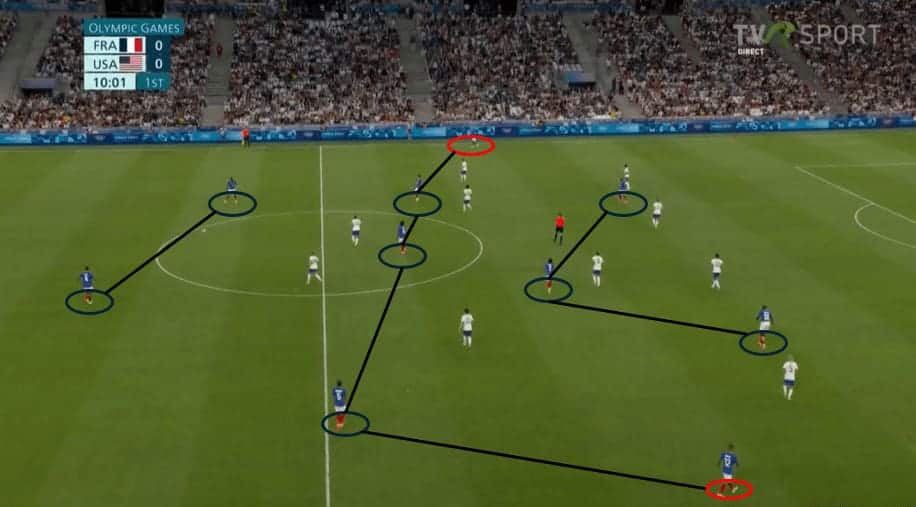
France Out Of Possession
Out of possession, France simplifies their approach with a 4-4-2 mid-block. Olise (marked in yellow) drops from his attacking role into central midfield, forming a second defensive line while maintaining the dual striker partnership.
This structure aims to create a solid defensive block, making it challenging for the opposition to break through.
The midfielders and strikers work in tandem to apply pressure and intercept passes, effectively disrupting the opponent’s build-up play.
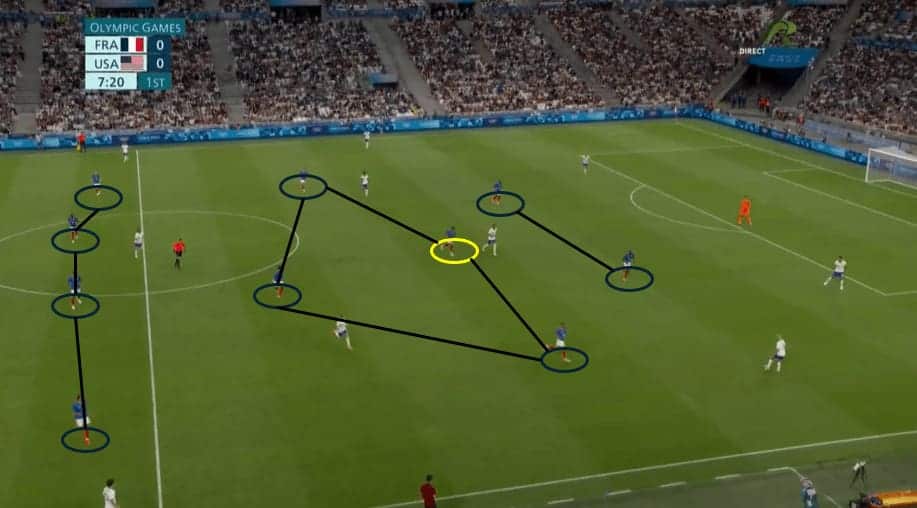
France Key Player – Michael Olise
Michael Olise has emerged as one of the world’s top young talents over the past season, earning a move to Bayern Munich for the 2024/2025 season.
An electric winger known for his exceptional ball-carrying abilities, stop-motion dribbling, and the intelligence and technical skill to play as a central midfielder.
In the Olympics, he’s been playing as a number 10, already scoring 1 goal and providing two assists in the first three matches, tying him for first in assists in the competition.
Playing 1,335 minutes, the 22-year-old demonstrates exceptional attacking characteristics, particularly in goal contributions per 90 minutes, where he ranks in the 96.75th percentile, and expected goal contributions per 90 minutes, where he ranks in the 90.25th percentile.
His shooting ability is notable, with a 97th percentile rank for shots per 90 minutes.
Olise also excels in dribbling, ranking in the 91.7th percentile, and touches in the opponent’s penalty area, where he ranks in the 73.5th percentile.
His passing skills are highlighted by high ranks in received passes per 90 minutes (85.8th percentile) and dangerous passes per 90 minutes (87.03rd percentile).
Defensively, he is effective in duels, with a defensive duel per 90 rate placing him in the 69.4th percentile and an aerial duel win percentage in the 78.8th percentile.
Overall, Olise’s radar chart reflects a well-rounded player who contributes significantly to both the offensive and defensive aspects of the game, making him capable of playing in central midfield.
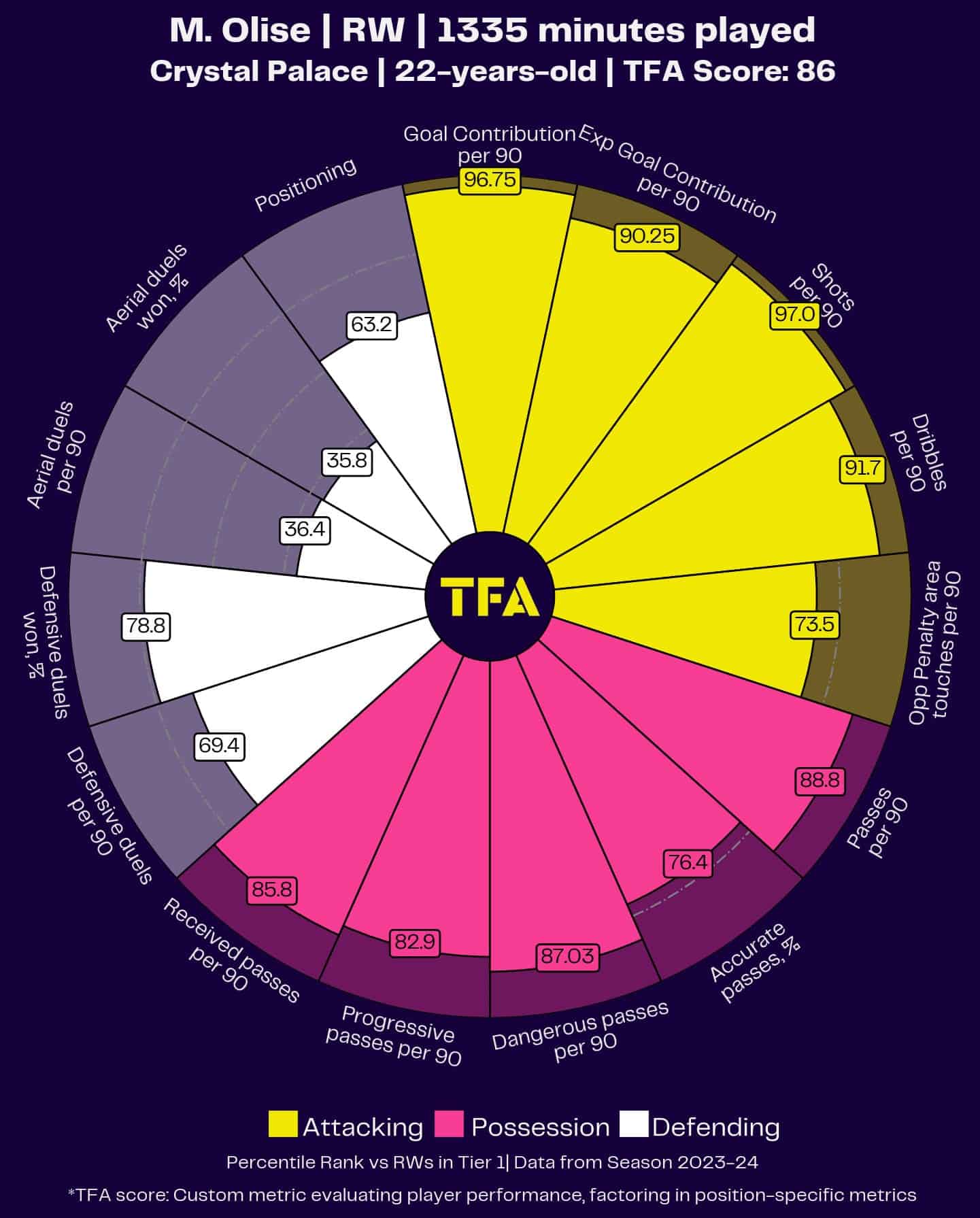
Olise’s brilliance as a ball carrier is evident through his numerous penetrating carries into dangerous zones in the final third and the opponent’s penalty box.
He plays mostly from the right side of the pitch, as he tends to drift to his natural right-wing position.
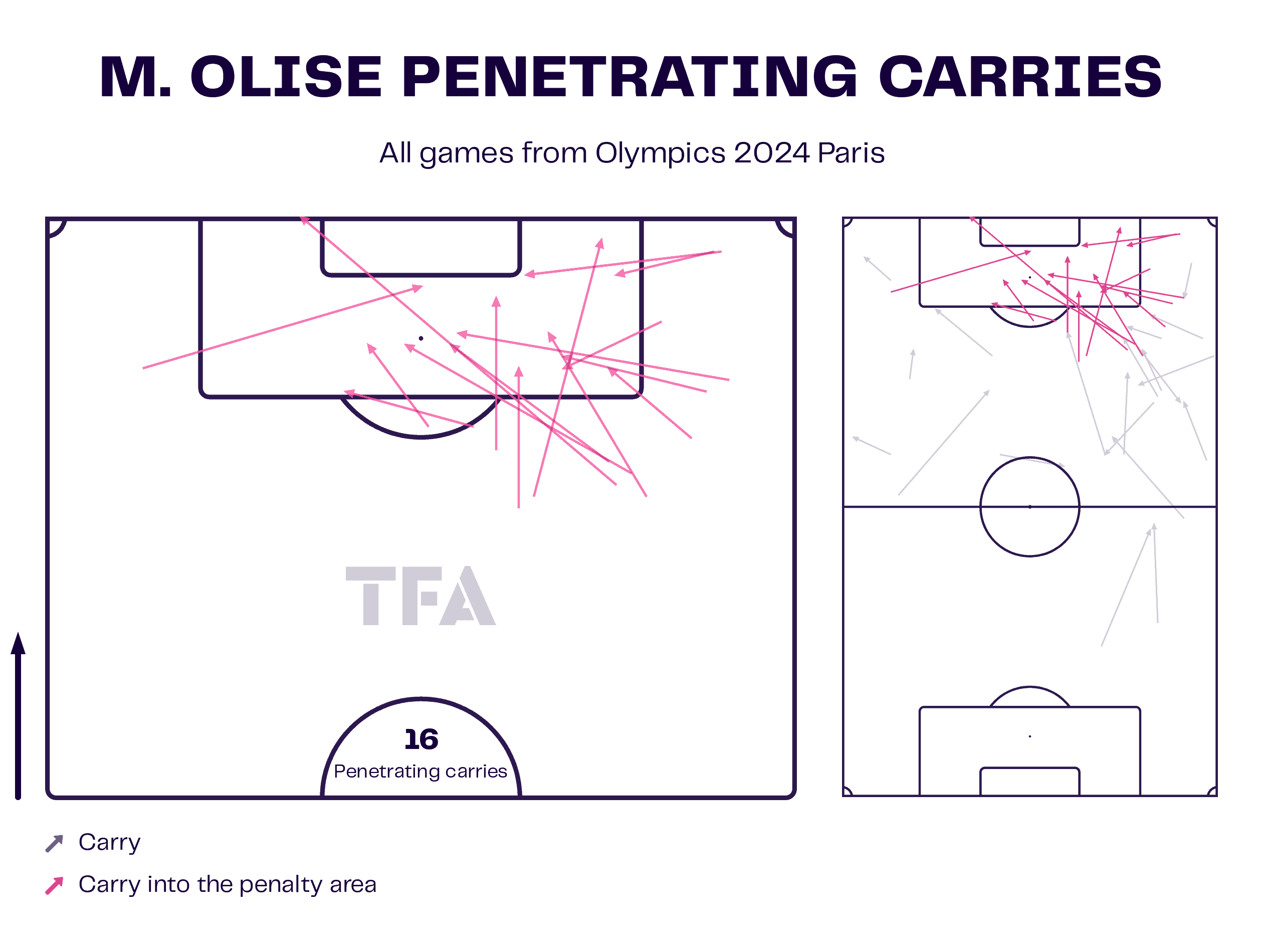
His progressive pass map highlights his proficiency with the ball in these critical areas.
Olise is able to find pockets of space where he can turn and play his strikers, which is part of the reason he is so trusted to play this number 10 role over other French Talent like Ryan Cherki.
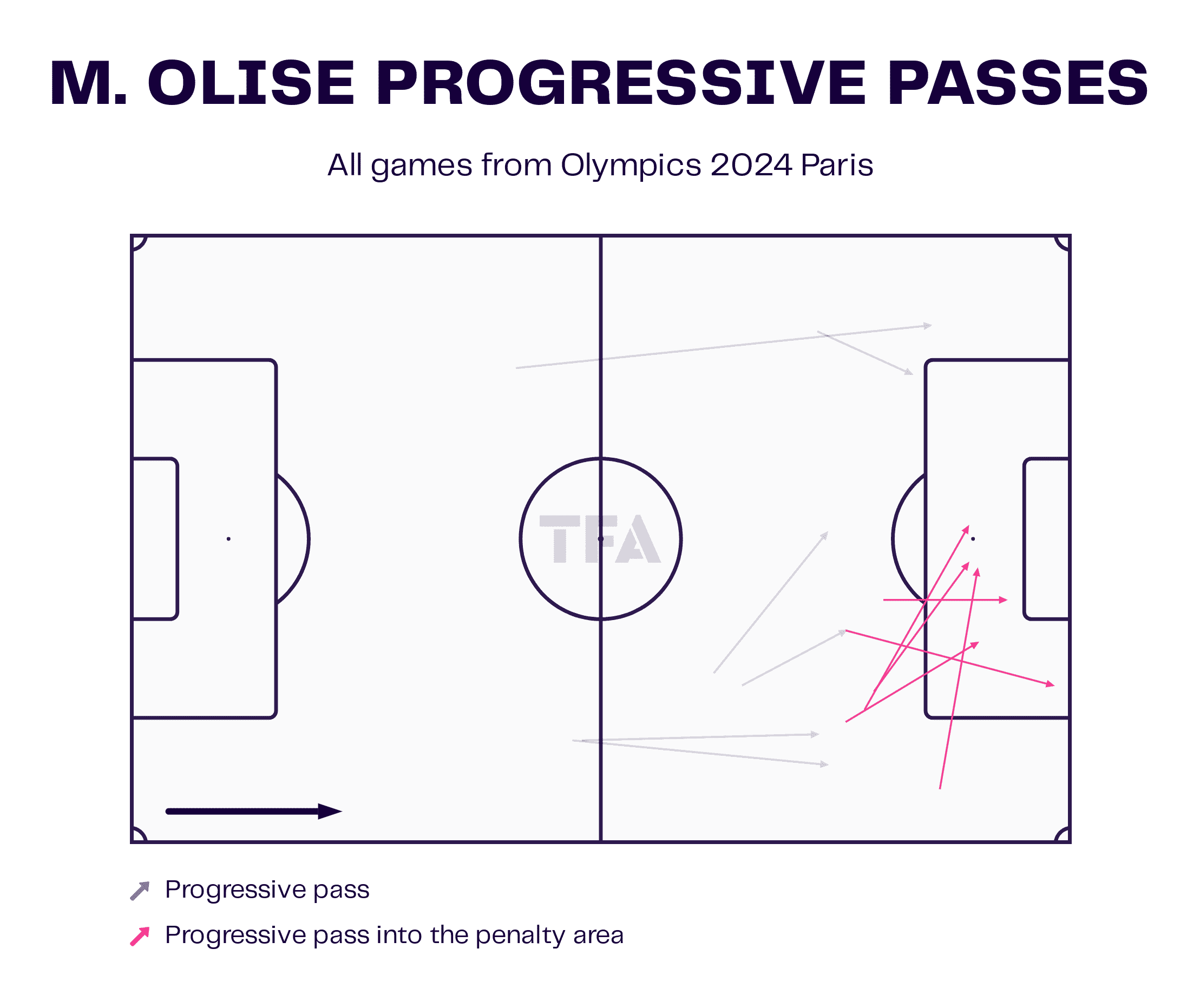
His heatmap reveals a commendable defensive work rate, showcasing his ability to track back when necessary.
It also illustrates his dominance across the attacking width, particularly on the right side, reflecting his natural position as a right-winger.
This versatility allows him to execute dangerous plays from anywhere in the front three.
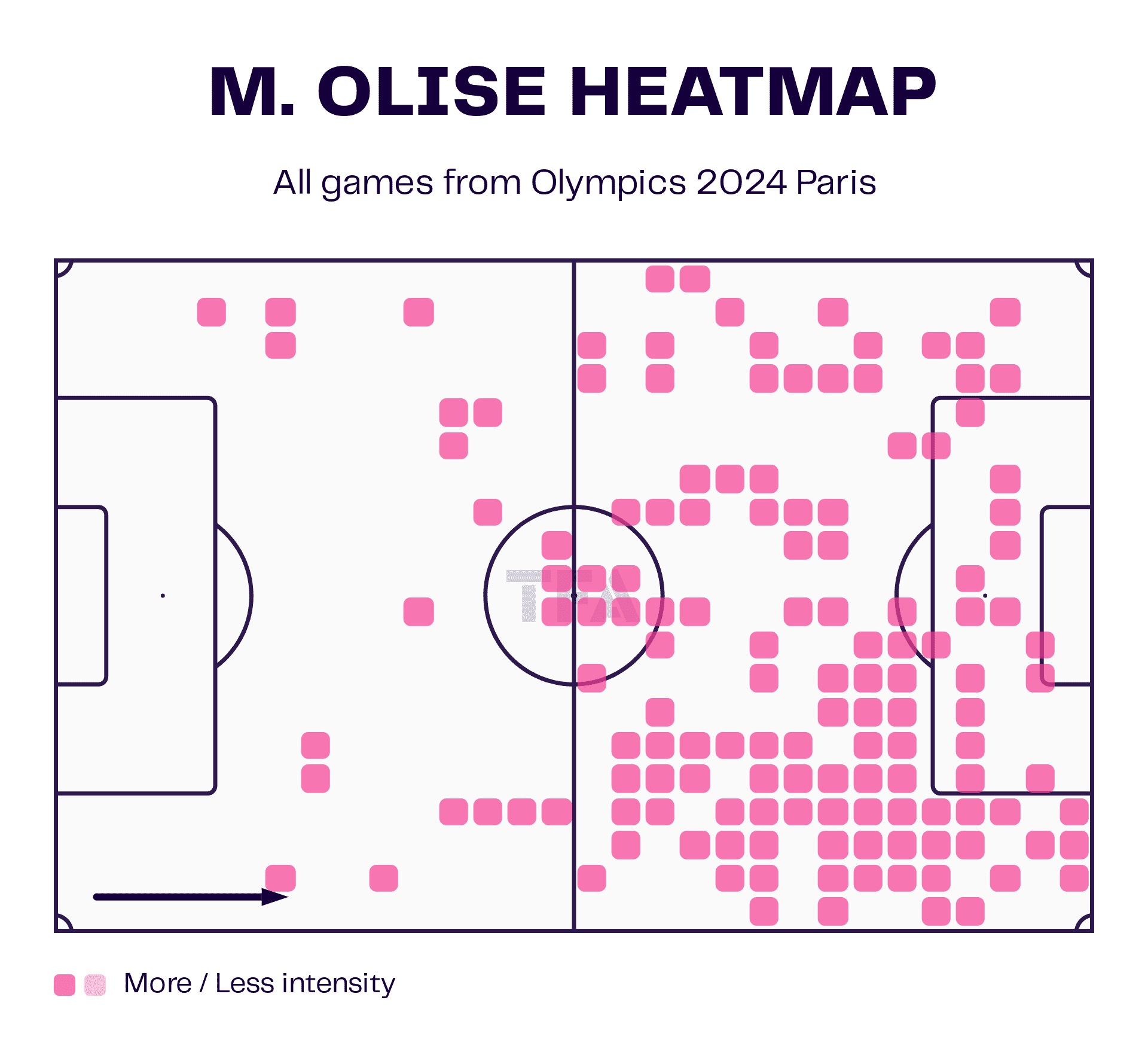
France Upcoming Match
France will face Argentina in the first round of the knockout stages. Despite finishing second in their group, Argentina remains a strong contender for the gold medal.
They boast senior players like Julian Alvarez, Otamendi, and Rulli, along with young talents Thiago Almada and Ezequiel Fernandez. Argentina typically lines up in a 4-4-2 formation, with more attacking-minded players in the wider positions of the second block.
This setup allows them to counterattack with greater threat while maintaining a solid mid-block for defensive stability when necessary.
Although Argentina finished second in their group, facing them will still be a significant challenge for France if they want to advance to the next stage in their pursuit of Olympic gold.
This matchup will be crucial for both teams as they aim to progress further in the tournament.
Morocco Tactical Analysis
Morocco lines up in a 4-4-2 formation, with their star player Hakimi playing in his natural position to maximise his output.
Instead of a dual-striker partnership, they utilise a second striker, with Khannous playing behind their star, Rahimi.
This formation allows Hakimi to excel on the flanks while Khannous supports Rahimi in the attacking phase, creating a dynamic offensive setup that leverages their key players’ strengths effectively.
Morocco In Possession
Tarik Sektioui’s approach to setting up his team for attacking play emphasises fluidity, creativity, and quick transitions.
Instead of giving specific instructions, he allows his players the freedom to roam into available spaces, akin to a relationist style.
This method encourages players to exploit opportunities dynamically, fostering a more adaptable and unpredictable offensive strategy.
This fluidity in movement and positioning enables the team to create and capitalise on chances, making them a formidable attacking unit.
From the image, we can observe Sektioui’s approach in action.
The deep-lying playmaker (marked in red) moves into open space to receive the ball.
Simultaneously, the midfielder (marked in yellow) adjusts his position to exploit available space.
Notice the two players on the left wing (marked in black) standing close together, ready for a quick transition to the other side of the pitch to create an overload.
They determine their positions based on the flow of play, readjusting and separating once the play breaks down.
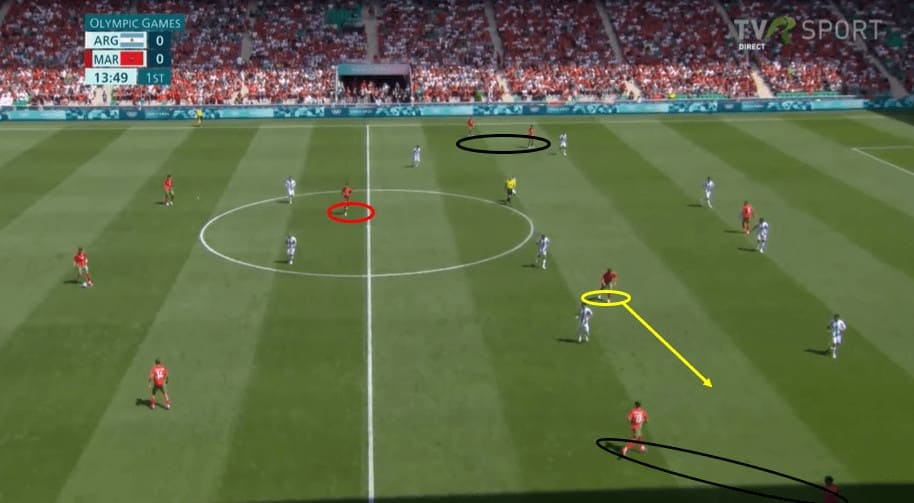
Morocco Out Of Possession
Out of possession, Morocco adopts a classic 4-4-2 mid-block.
However, their wide right midfielder (marked in yellow) pushes slightly ahead and centrally, leveraging Hakimi’s defensive prowess and rapid pace to cover the flank.
This strategy creates a compact defensive structure, as seen in the 2022 World Cup, and applies the same philosophy to their younger players.
This compactness makes them difficult to break down and allows Hakimi to effectively utilise his speed and defensive skills.
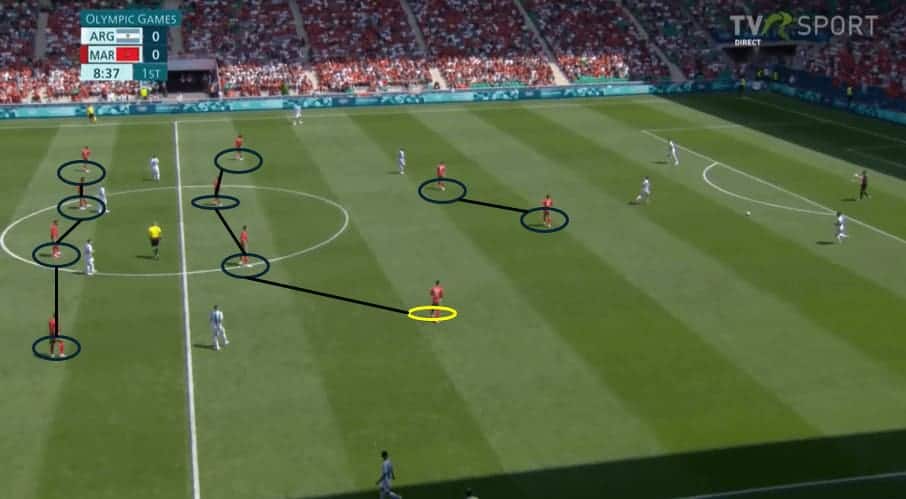
Key Player – Soufiane Rahimi
It’s challenging to discuss the best players in the Morocco national team without mentioning stars like Hakimi, Mazraoui, or Brahim Diaz.
However, Soufiane Rahimi has been the standout performer this campaign.
The 28-year-old, currently playing in the UAE, is one of the veteran call-ups for the Olympics, and it’s evident why.
His experience and skill have significantly impacted the team’s performance, making him a crucial asset in their pursuit of success.
With 1,632 minutes played, the 27-year-old shows notable attacking capabilities, ranking in the 72nd percentile for goal contributions per 90 minutes and the 76th percentile for expected goal contributions per 90 minutes.
His shooting proficiency is evident, ranking in the 94th percentile for shots per 90 minutes.
Rahimi is also strong in dribbling, ranking in the 72nd percentile, and touches in the opponent’s penalty area, where he ranks in the 96th percentile.
However, his passing and defensive metrics indicate areas for improvement, especially in progressive passes per 90 minutes (40th percentile) and defensive duels per 90 minutes (3rd percentile).
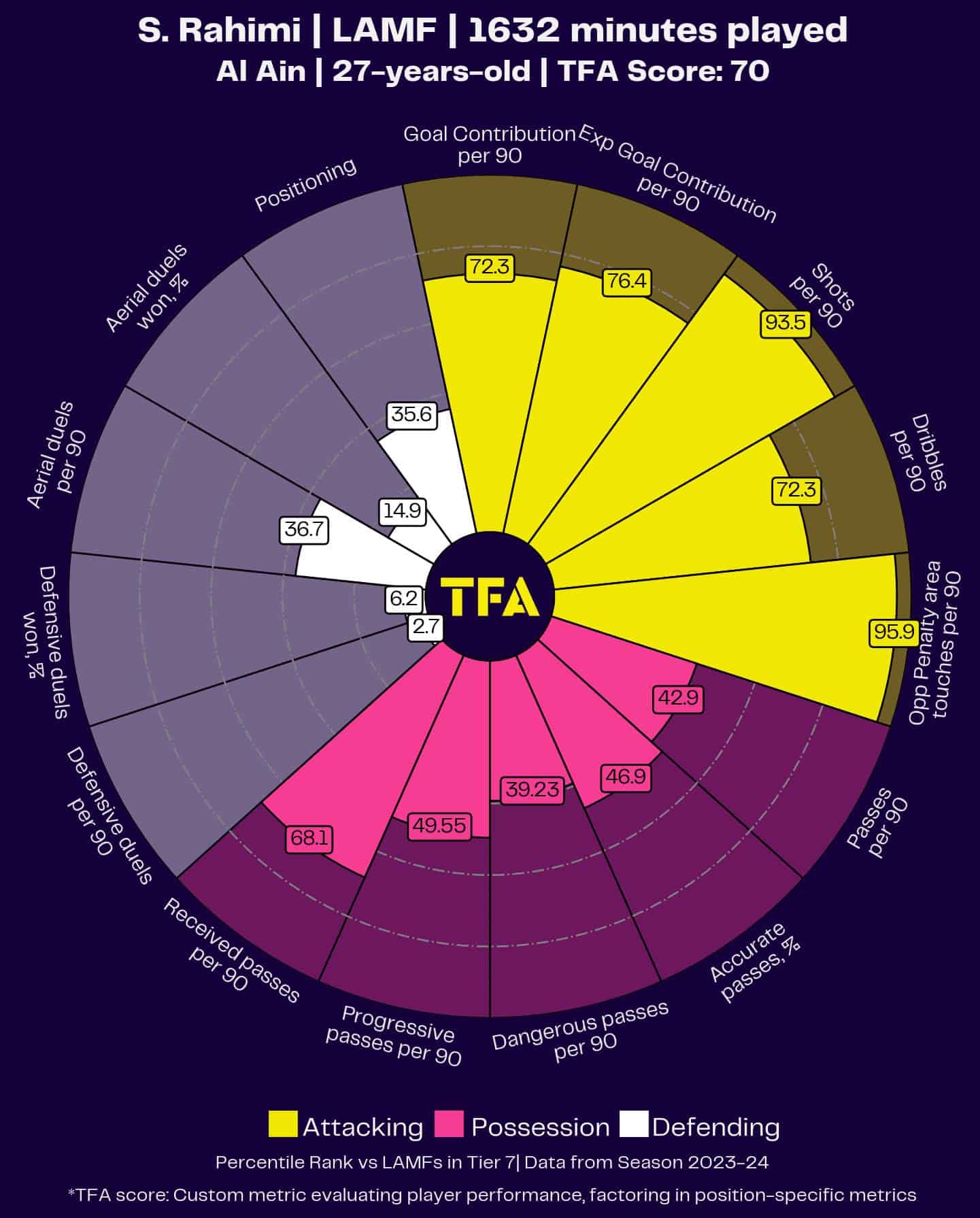
With eight shots and four goals, including two penalties, across three matches, Rahimi is off to an excellent start.
He is the current top scorer of the 2024 Olympic campaign. His shot-map graphic provides more details about this aspect of his game.
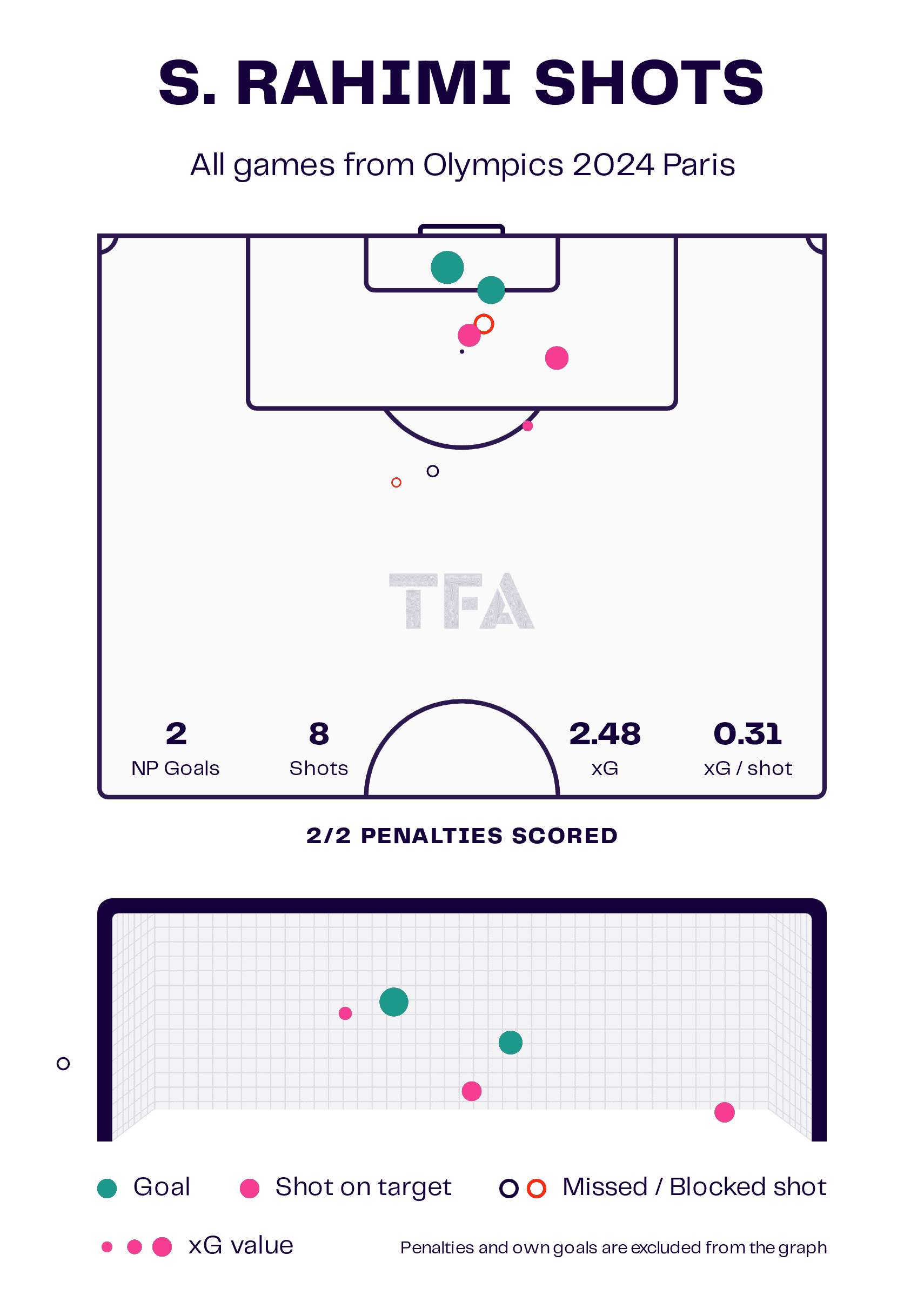
Notably, his touch map shows numerous touches in midfield and wide areas, indicating his active role in coming short, receiving the ball, and aiding in ball progression—link-up play, in other words.
This shows that Rahimi is not just a static striker but is willing to do extra work to push his team forward.
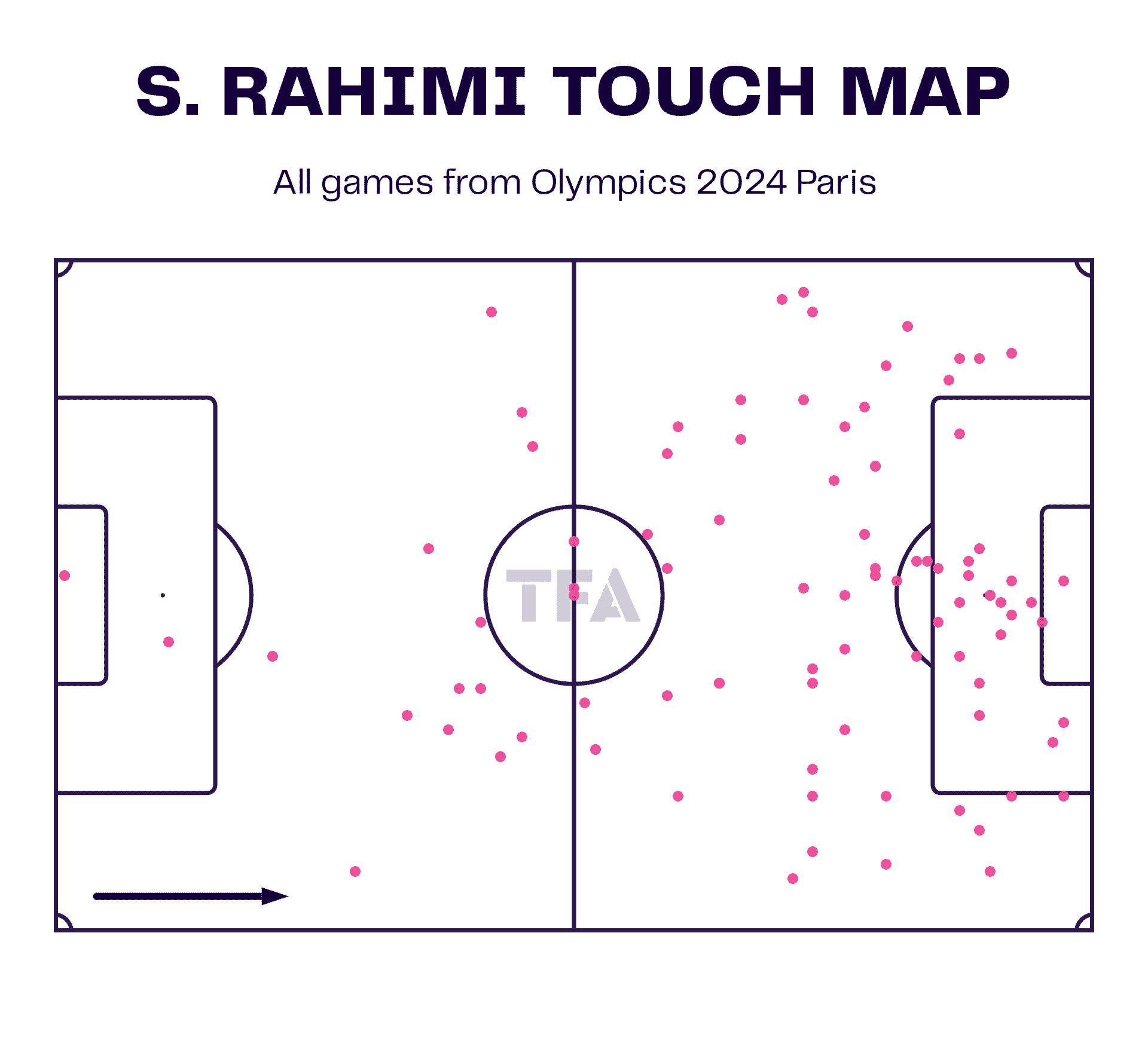
The heatmap also highlights his intensity in midfield and defensive zones, showcasing his tireless efforts in tracking back and helping his team regain possession.
Rahimi’s willingness to engage in various aspects of attacking play, combined with his goal-scoring prowess, highlights his dynamic and versatile role on the field, making significant contributions to his team’s offensive efforts.
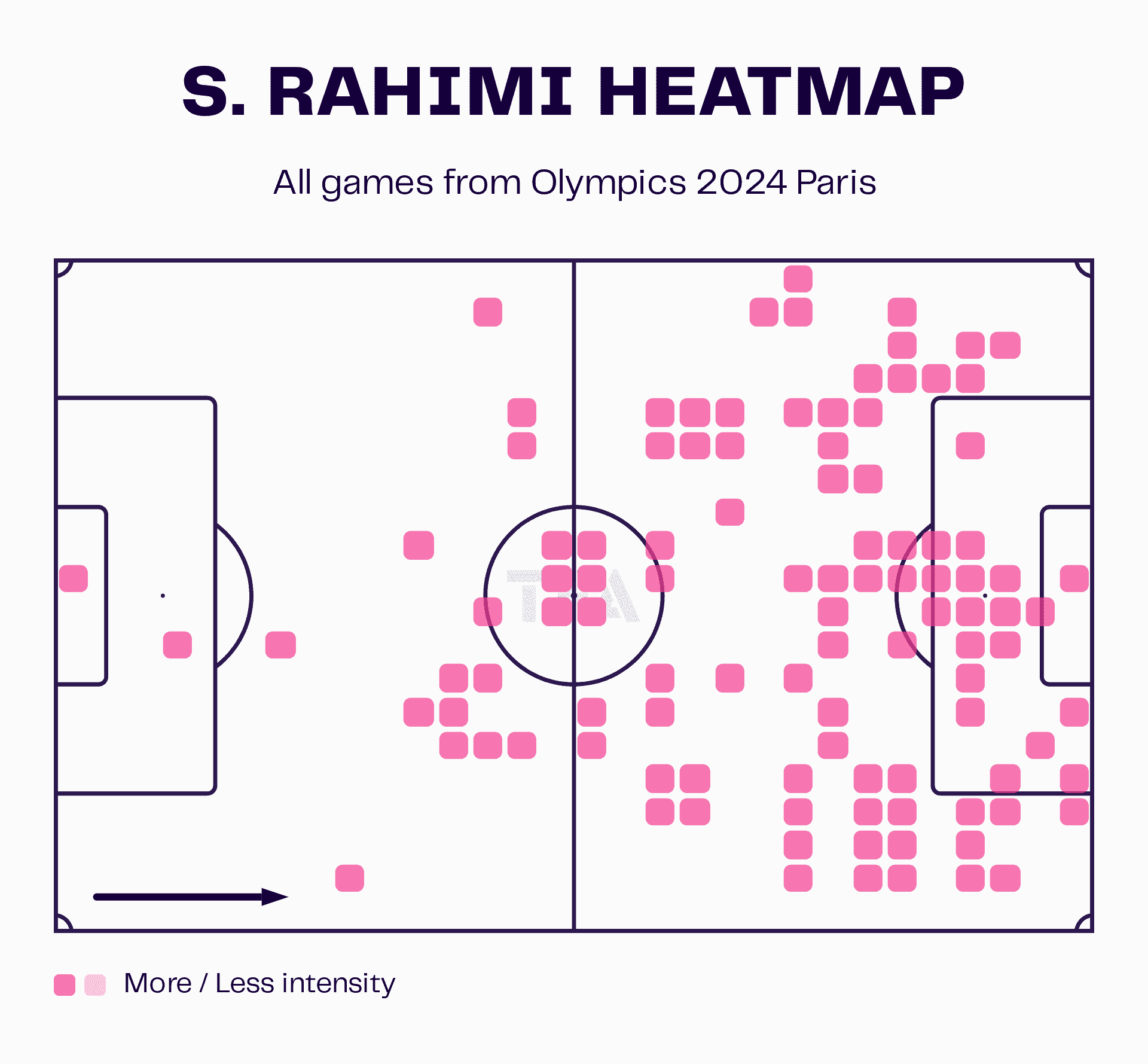
Morocco Upcoming Match
Morocco will face the USA in the first round of the knockout stage.
Despite suffering a heavy 3-0 defeat against France in their first match, the American team bounced back with 4-1 and 3-0 victories in their subsequent games.
Featuring a talented young core with Aaronson, Tessmann, and Parades, along with veterans like Robinson and Zimmerman, the USA will aim to maintain their momentum.
Their classic 4-3-3 formation focuses on possession and breaking down opponents, posing a significant challenge for Morocco, especially against the experienced centre-back partnership.
Morocco’s biggest struggle may be generating attacking output against this formidable defence.
Egypt Tactical Analysis
Interestingly, Egypt has not included Mohamed Salah in their Olympic squad, opting for Mohamed Elneny and Zizo instead.
This decision reflects a greater emphasis on trusting their youth players.
Elneny and Zizo bring valuable experience and leadership to the squad, balancing the team’s youthful energy and potential with veteran presence and stability.
This blend aims to foster development while maintaining competitive performance in the tournament.
Egypt typically adheres to their classic 4-3-3 formation, and we’ll delve into more detail about this setup.
Egypt In Possession
Egypt prefers to build up play in a wide 3-4-3 formation, with Elneny (marked in yellow) dropping between the two centre-backs.
This tactic creates an overload on each flank, as marked in red, where two players position closely to facilitate quick transitions to the advantageous side.
However, this setup can lead to a loss of midfield control since they are left with only two central midfielders.
The trade-off is a potential numerical advantage in wide areas, aiming to exploit these zones effectively in attack.
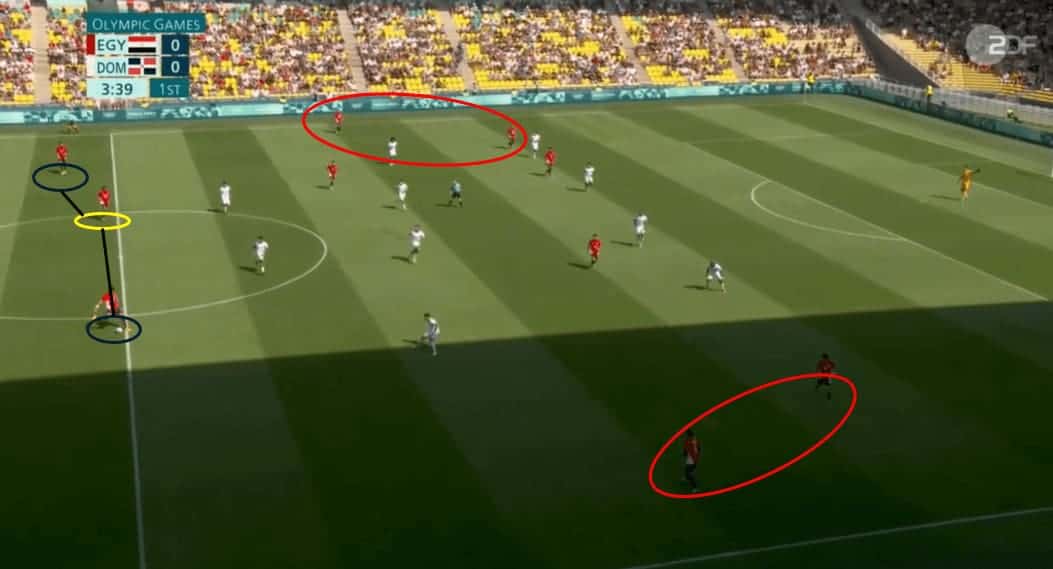
Egypt Out Of Possession
Elneny is the star of the team, and Egypt utilises him as the anchor in midfield.
They defend in a 4-3-3 formation with Elneny (marked in yellow) as the central holding midfielder, allowing him to occupy central zones and drift left or right as needed.
This setup is unusual, as it features a defensive first line of three players, but it has been effective for Egypt so far.
Elneny’s central role ensures that he can influence the game defensively and support the team’s structure.
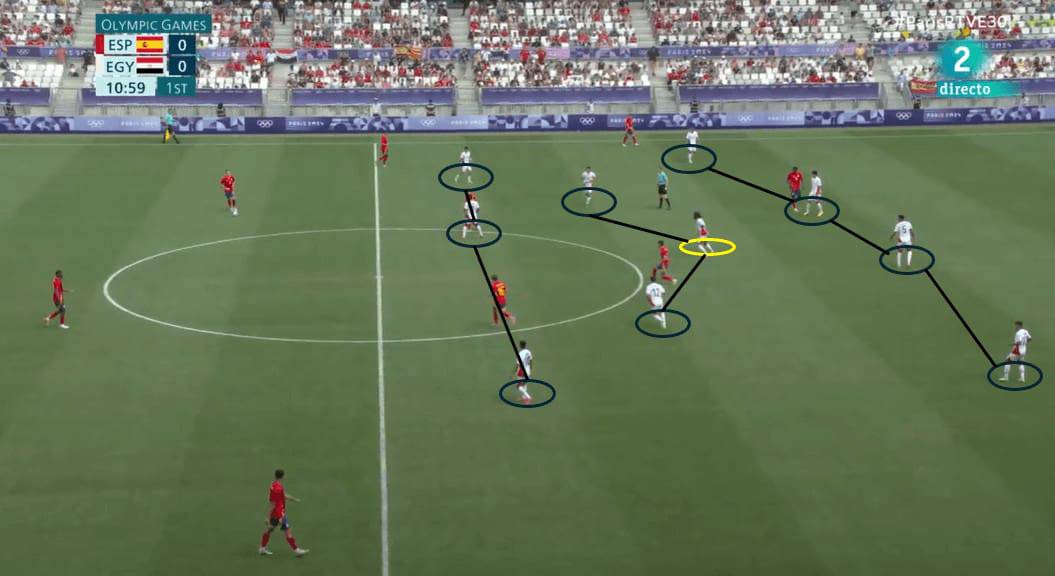
Egypt Key Player – Mohamed Elneny
Calling up Mohamed Elneny as a veteran was an excellent decision.
Midfielders are the backbone of a team, and there’s no better veteran for this position than Elneny.
Despite facing many injuries and limited minutes over the past 2-3 years, Elneny has returned to the Olympic games as if nothing has changed, demonstrating his resilience and value to the team.
His experience and skill set are invaluable assets, providing stability and leadership on the field.
Reviewing the Olympic campaign matches, Elneny’s heatmap is extraordinary, showing his presence all over the pitch, contributing both defensively and offensively.
Elneny has always been an engine for his team and is demonstrating that role once again in these games.
His remarkable work rate and ability to influence the game in multiple areas underscore his importance to the team’s overall performance.
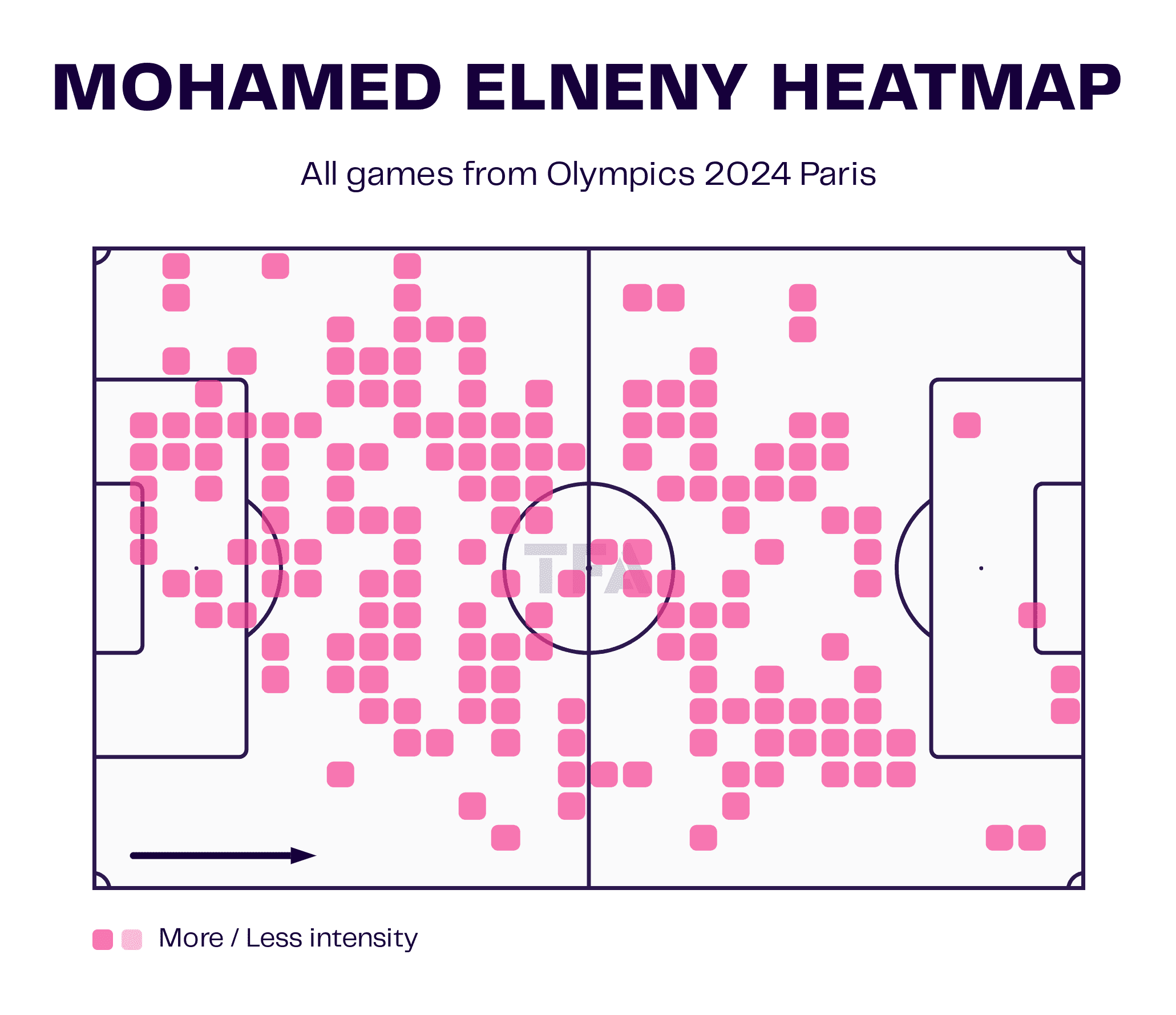
His progressive pass map highlights his attacking prowess, with three key passes into the penalty box and another three just outside the 18-yard box.
Elneny has not only taken on a defensive role but has also assumed the responsibility of being a creative outlet for his team.
His ability to contribute both defensively and offensively underscores his versatility and importance on the pitch, providing stability and creativity in equal measure.
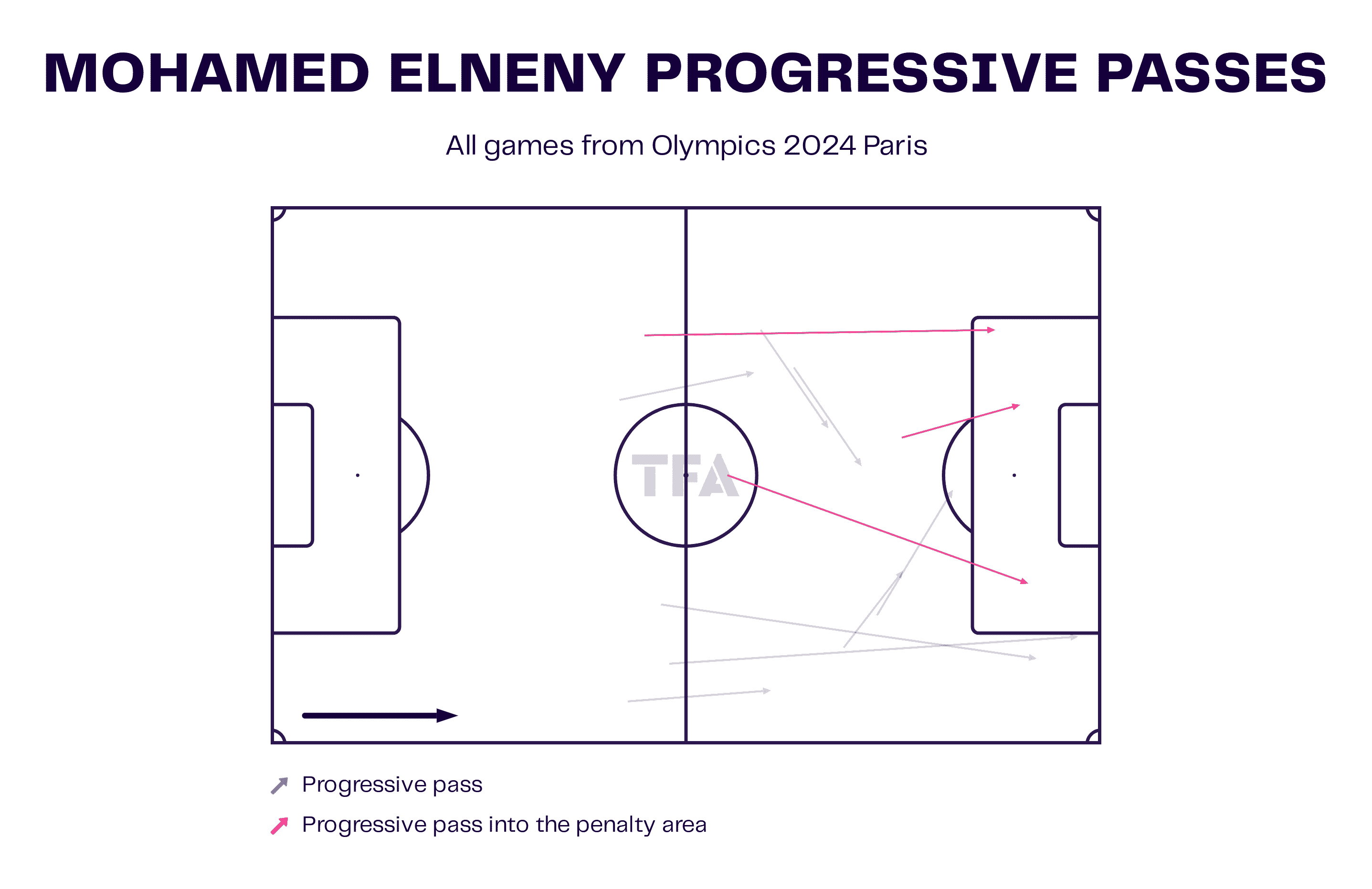
His defensive territory map underscores his effort, with numerous interceptions and defensive actions in the defensive third and his own penalty box, showcasing his engine role.
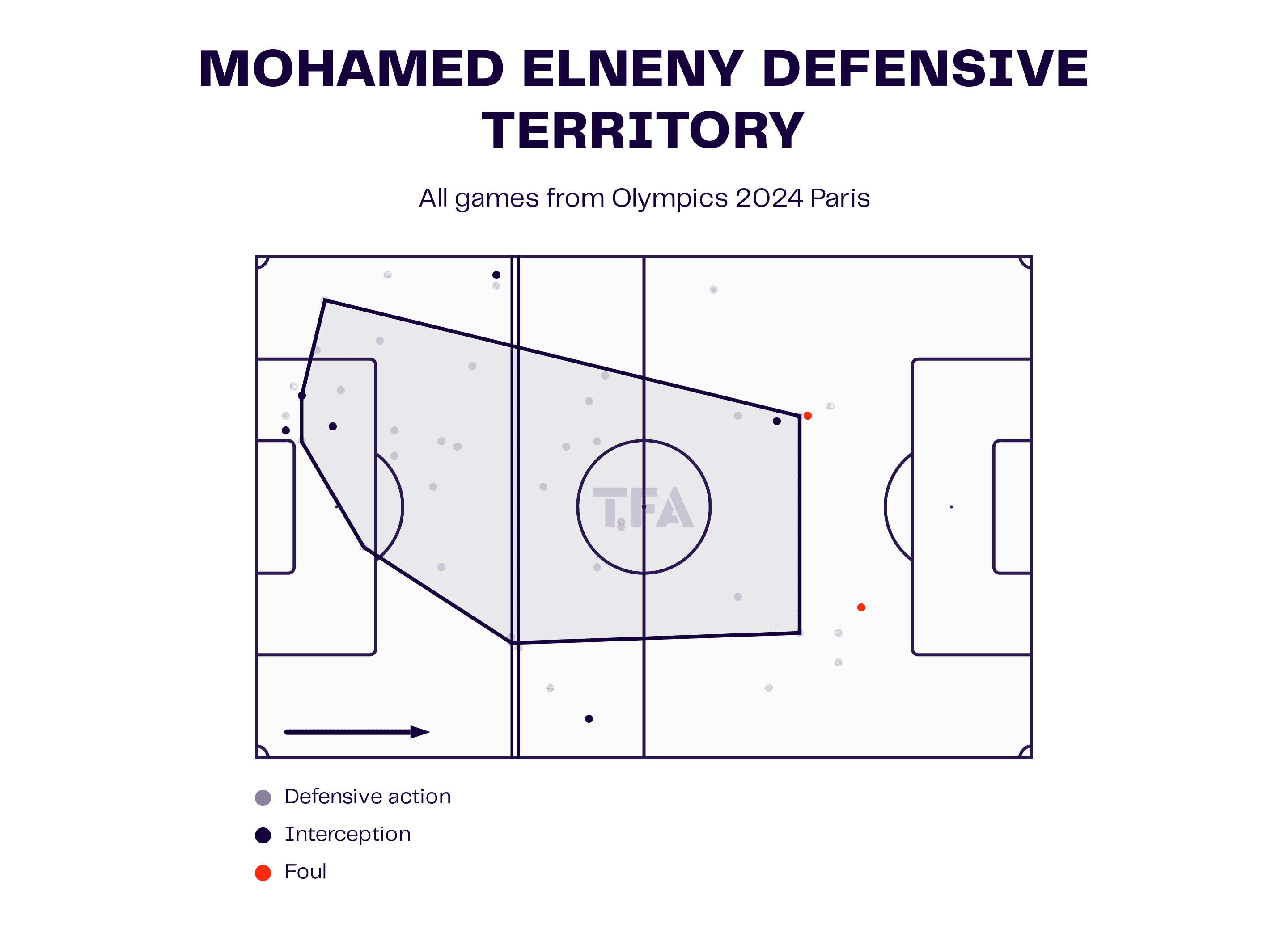
Egypt Upcoming Match
Egypt will face Paraguay in the first round of the knockout stage.
Egypt has had close matches, including a 0-0 draw, while Paraguay lost their first match 5-0 to Japan but won their next two with tight scores.
Paraguay hasn’t called up notable veterans like Almiron or Oscar Romero, and Egypt is without Mohamed Salah.
Both teams have shown resilience, and this matchup promises to be exciting and closely contested, with the outcome depending on the day’s performance.
Japan Tactical Analysis
Japan has decided not to call up any overage players, putting full trust in their youth for this Olympics campaign.
Both the senior and youth Japanese teams typically line up in a 4-2-3-1 formation, utilizing their intelligent wingers to push the team forward in transition.
This Japanese team boasts excellent quality and potential future stars in European football, such as Koki Saito, Kota Takai, and Shunsuke Mito.
Their dynamic play style and reliance on young talent highlight their strategy for success in the tournament.
Japan In Possession
In possession, the Japanese team prefers a 2-3-5 formation, leveraging attacking strength and numerical superiority in the opponent’s half.
They deploy a deep-lying playmaker (marked in yellow) between the two fullbacks.
The five attackers shift up and down the pitch as needed, aiming to bypass the opponent’s middle defensive block and progress the ball.
This numerical advantage in attack allows them to execute their offensive strategies effectively.
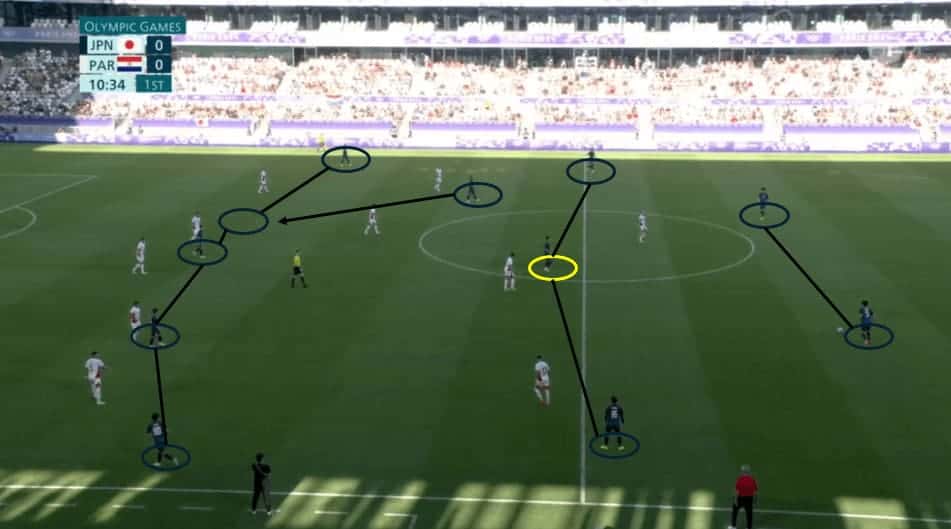
Japan Out Of Possession
Japan’s approach to the 4-4-2 formation out of possession in the Olympics is strategic and disciplined.
They maintain a compact shape with the midfield and defence lines close together to minimise space for the opposition.
The team often employs a high press, particularly against teams that struggle with building from the back, with forwards and midfielders pressing aggressively to force turnovers.
Wingers tuck in centrally to assist the central midfielders, while strikers drop back to block passing lanes through the middle.
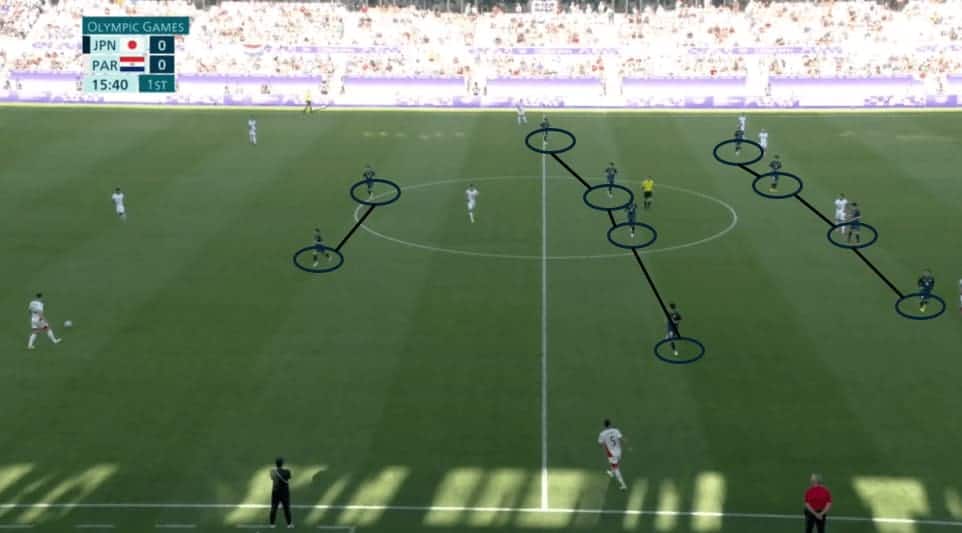
Japan Key Player – Koki Saito
Koki Saito is a fascinating winger, a creator type who can control a game independently and speed and slow down attacking transitions on his own, finding open spaces to exploit or play teammates into.
He’s highly intelligent while dribbling, with a low centre of gravity for quick direction changes that deceive opponents.
Although he hasn’t played for the senior Japan team yet, he has significant experience in youth international football, with 10 matches—seven with the U23 and three with the U20 squad.
Given his current form, a call-up to the senior squad for future Japan matches seems likely.
With 1,672 minutes played, the 22-year-old shows his strengths and areas for improvement.
Offensively, Kubo ranks in the 59th percentile for goal contributions per 90 minutes and the 56th percentile for expected goal contributions per 90 minutes.
His shooting ability is decent, with a 70th percentile rank for shots per 90 minutes.
Kubo is effective in dribbling, ranking in the 74th percentile, and touches in the opponent’s penalty area, where he ranks in the 79th percentile.
In terms of passing, Kubo performs well in received passes per 90 minutes, ranking in the 48th percentile.
He shows a stronger performance in progressive passes per 90 minutes, where he ranks in the 72nd percentile, and in dangerous passes per 90 minutes, ranking in the 58th percentile.
Defensively, Kubo’s metrics indicate areas for development, with lower rankings in defensive duels per 90 minutes (5th percentile) and aerial duels won percentage (45th percentile).
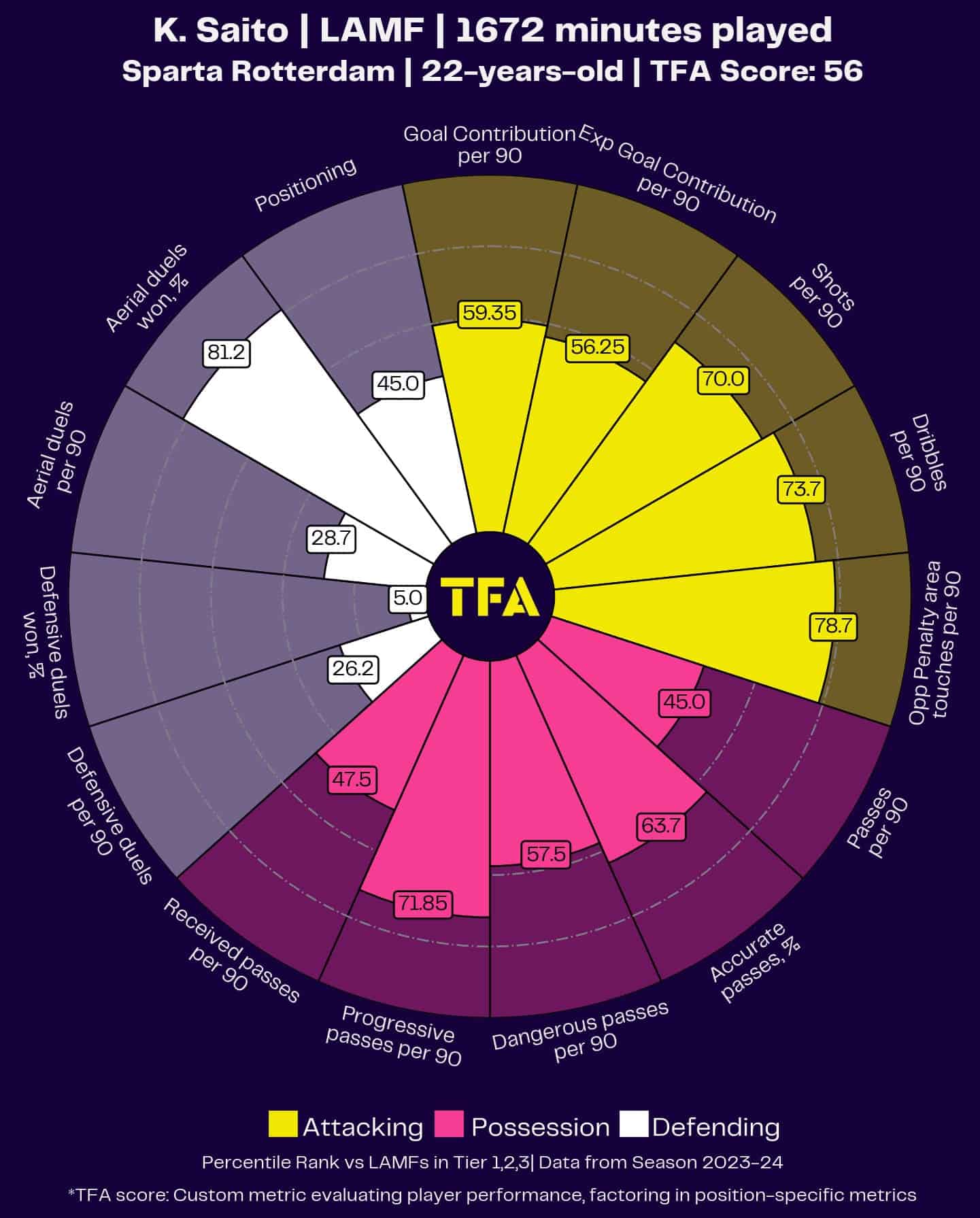
Saito plays on the left wing for Japan but can also slot into a left wing-back position when necessary.
Interestingly, he shows high intensity in the wide areas on the left side of the pitch, with less activity in central zones.
Unlike many wingers who cut inside for shots, Saito prefers to penetrate space behind on the left.
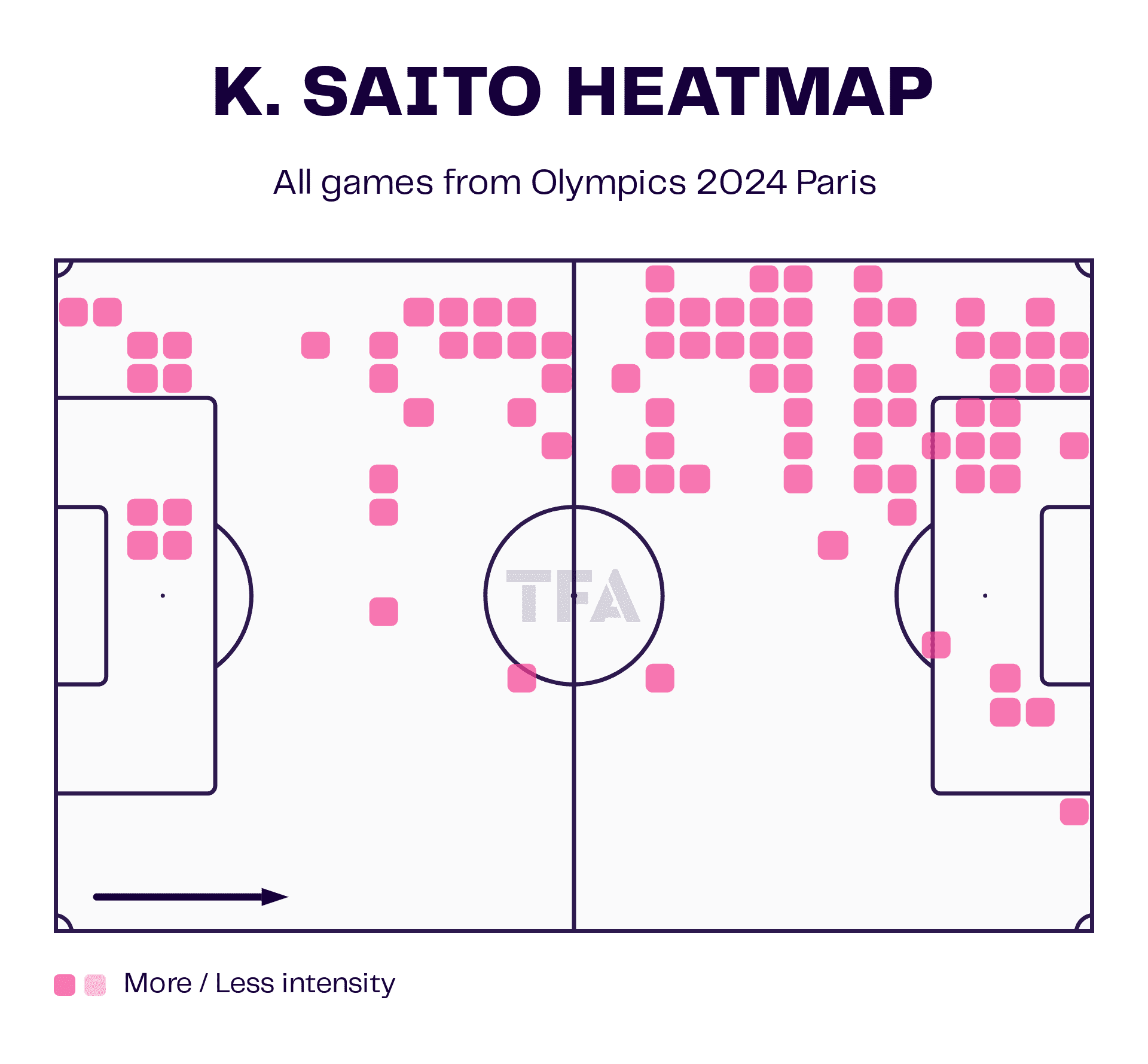
Looking at his winger actions graphic, we see many dribbles and crosses from just outside the box.
At the same time, his penetrating carries graphic highlights his skill in tight spaces, effectively exploiting gaps even with crowded defenders.
Saito is a fearless and highly intelligent winger, constantly seeking to take on players.
The two graphics below are clear evidence of his relentless drive and tactical awareness, showcasing his ability to impact the game significantly by creating opportunities and maintaining pressure on the opposition.
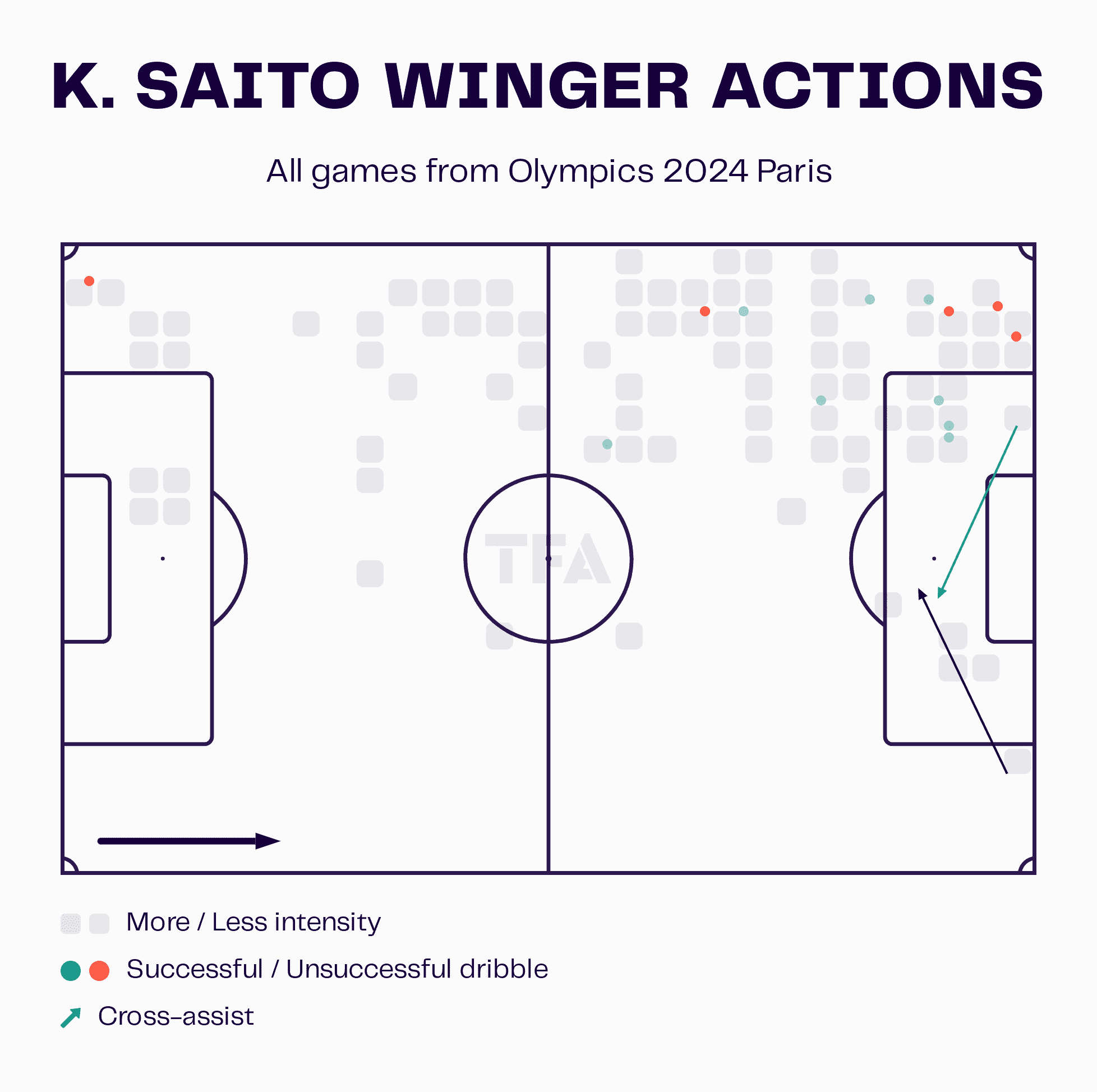
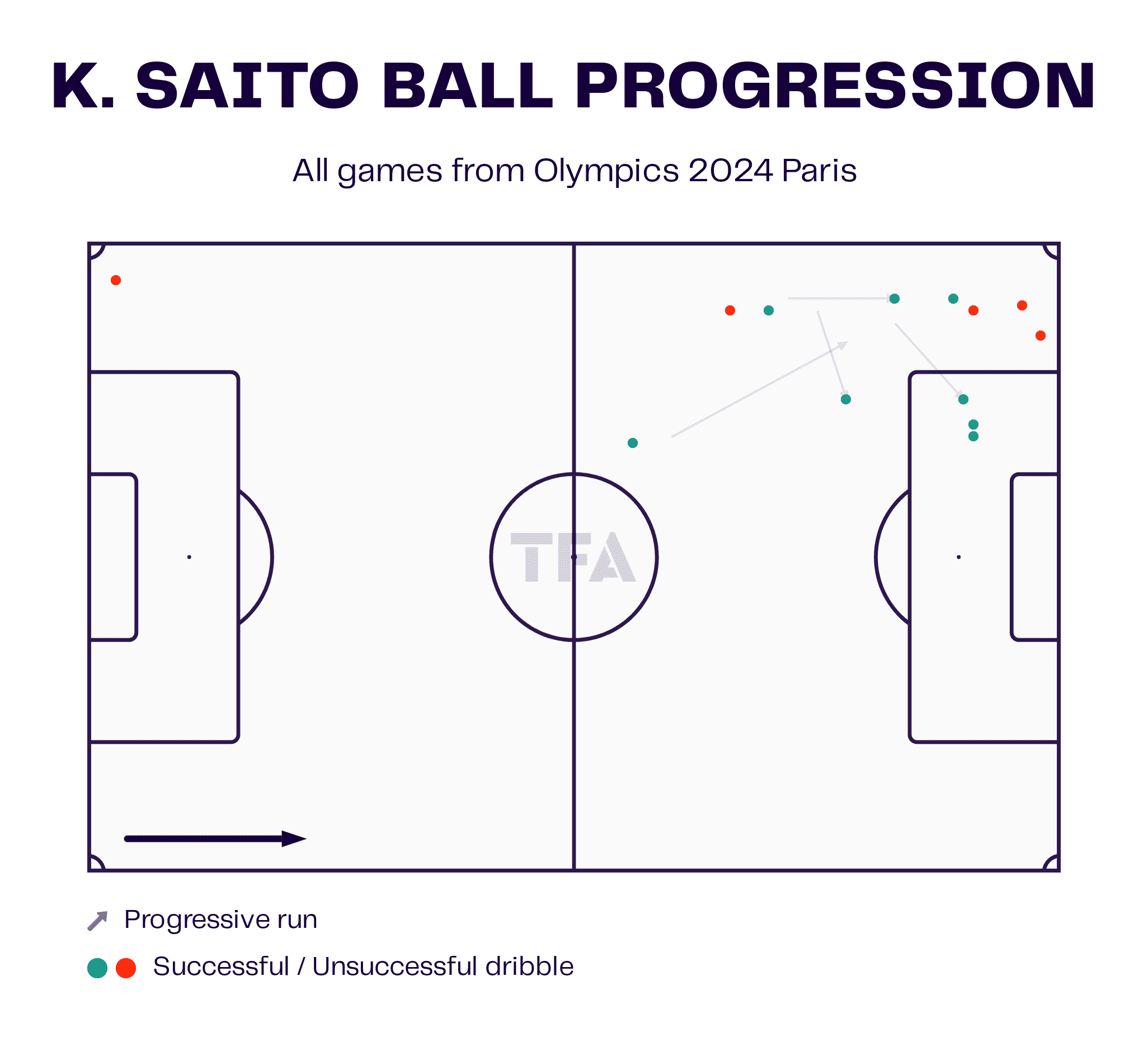
Japan Upcoming Match
Japan will face Spain in the next knockout match.
Despite Japan topping their group and Spain finishing second, Japan are not necessarily the favourites.
Spain lost their group lead after making major changes for their final game against Egypt, who surprisingly won and topped the group.
Spain remains a strong contender for the gold medal, boasting a lineup with significant senior experience, including players like Fermin Lopez, Pablo Barrios, Juan Miranda, Miguel Gutierrez, Eric Garcia, and Sergio Gomez.
Japan, relying entirely on their youth with no overage players, will face a tough challenge against arguably the strongest team in the tournament.
Nonetheless, Japan has shown great performances so far, making the upcoming match highly competitive.
Conclusion
In conclusion, the Olympic football tournament has reached an exciting phase, with France, Morocco, Egypt, and Japan emerging as the top teams from their respective groups.
Each team has displayed unique strategies, exceptional skills, and standout performances that have propelled them to the forefront of the competition.
France’s dynamic formation and the brilliance of Michael Olise, Morocco’s potent attack led by Soufiane Rahimi, Egypt’s steadfast midfield anchored by Elneny Mohamed, and Japan’s versatile play spearheaded by Koki Saito have all been pivotal in their success.
As these teams advance to the knockout stages, facing formidable opponents like Argentina, USA, Paraguay, and Spain, their tactical acumen and individual talents will be put to the ultimate test.
The upcoming matches promise to deliver intense and thrilling football, with each team vying for Olympic glory.





Comments